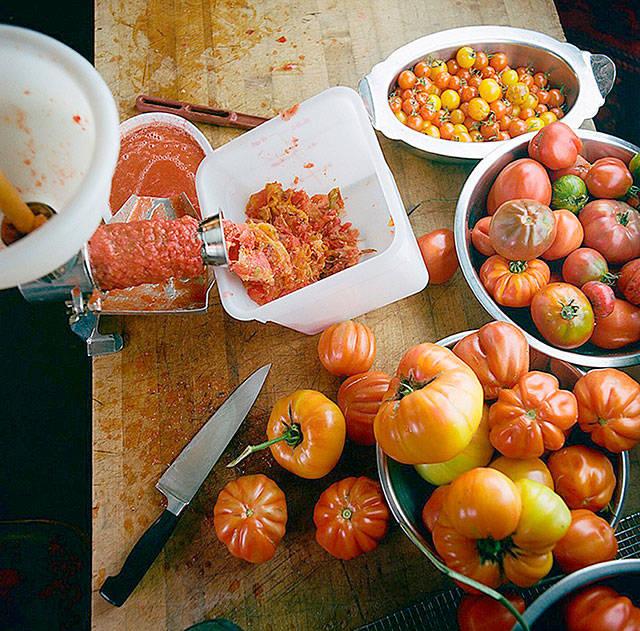Kurt Timmermeister has never been afraid of trying new things, but when digital photography overtook traditional film, the author, dairy farmer and former restaurateur of Seattle’s Cafe Septieme was uncharacteristically obstinate.
“I don’t have an interest in digital — there’s nothing about it that’s serious to me — but I love shooting film,” said Timmermeister, who landed on Vashon in 1991 while searching for a proper homestead to commit his roots. Seattle’s ever-climbing cost of living had priced him out of home ownership in the city, the first of many experiences later recounted in his acclaimed 2012 memoir, “Growing a Farmer.”
“I just stopped and I never picked up a camera again until this project,” he said, talking about the series of recipes, photographs and reflections gleaned from life on his Beal Road farm, now included in his newest volume of work released on June 4, “Farm Food II: Spring & Summer.” He will read from that book next week as part of Vashon Center for the Arts’ Garden Tour.
“[Film cameras] slow you down and make you experience moments certainly better than with a digital camera,” he said. “Now I’m seeing my farm in a new way, and I think that’s kind of profound and interesting and rare. After decades of being in the same place, you can see it in a new way.”
Today his property contains sweeping gardens, an orchard and a host of pigs and chickens, but the real stars of Kurtwood Farm are its 14 Jersey cows.
“We make cheese and ice cream. It’s really high quality, and we sell it all over Seattle, in grocery stores and restaurants,” said Timmermeister, who also offers his dairy products at Kurt Farm Shop on Capitol Hill.
The process for writing “Farm Food I and II” was guided less by captious line editors, Timmermeister said, and more by candidness; what’s left is vastly different than what he was used to printing with publishing house W.W. Norton.
“The essays are more personal,” he said of “Farm Food.” “It’s just kind of a strange leap of faith when you’re sending out personal writing to the public. It’s hard to gauge whether you’ve gone too far or not far enough, and there are so few people who will tell you anyway. If people like something, they’ll tell you. But it’s hard to hear good criticism.”
According to Timmermeister, many of the enterprises at the farm are readily misunderstood, from the slaughter of animals to the amount of time and effort needed to make a piece of cheese. “Farm Food” attempts to demystify his occupation while capturing the character of what Timmermeister unmistakably considers an increasingly rare and thus exceedingly special life. One spent during the spring and summer months, as he describes throughout “Farm Food II,” in the bright joyousness of nature — and in the kitchen, too, where he creates the dishes found throughout the book. But “Farm Food” also makes mention of the world beyond the farm, in excerpts where Timmermeister recalls the past, as well as the human moments he considers most affecting.
In the chapter titled “April,” Timmermeister describes the company of good friends who were assisting in the slaughter of a pig, the grisly work providing time for the otherwise busy men to spend together.
“Instead of a spectacle, it was something we needed to get done. With great care, certainly, but it was still a chance to hang out and talk for the two hours it took to do the hard work. The three of us are rarely together for that long without an interruption. None of us checked our emails or texts,” he writes. “What made this slaughter different was that Andrew had never seen an animal killed for meat. Matt and I have a fair amount of experience butchering animals. Today we watched Andrew and remembered when we had been in his shoes.”
Timmermeister said that he wanted his “Farm Food” series to deeply explore the background of his food, and what it means to take a recipe from the raw ingredients of the farm all the way to the table.
“To actually cook dinner is, to me, tremendously about context and less so about the actual meal, and most cookbooks deal with the actual meal. I want to know where this comes from, and why this is interesting, and what you’re making with it. That’s a way more interesting story to me. I hope I contribute to those areas the most,” he said. “And I like talking about Vashon. People like to hear about it.”
At 4 p.m. Saturday, June 23, Timmermeister will discuss his new book and give a lecture in the Katherine L. White Hall at Vashon Center for the Arts, joining the annual garden tour where he will show nearly 60 of his selected photographs. Timmermeister said that the engagement will “hopefully illustrate this idea of experiencing a time of day, and weather, and what happens when you look out the window and don’t download that experience.”
“I just kind of like making things,” he said. “There are not a lot of people who make things anymore. There are not many people who raise food anymore. There’s an interesting culture here, and I want people to see it.”
“Farm Food II: Spring & Summer” is available at several Vashon retailers and at kurtwoodfarms.com.



